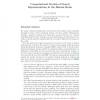868 search results - page 11 / 174 » Learning Object Representations Using Sequential Patterns |
PR
2007
13 years 7 months ago
2007
In this paper we address the problem of how to learn a structural prototype that can be used to represent the variations present in a set of trees. The prototype serves as a patte...
ALT
2008
Springer
14 years 4 months ago
2008
Springer
Abstract For many centuries scientists have wondered how the human brain represents thoughts in terms of the underlying biology of neural activity. Philosophers, linguists, cogniti...
TKDE
2008
13 years 7 months ago
2008
Given a large spatio-temporal database of events, where each event consists of the fields event ID, time, location, and event type, mining spatio-temporal sequential patterns ident...
PR
2010
13 years 5 months ago
2010
Wavelet analysis has found widespread use in signal processing and many classification tasks. Nevertheless, its use in dynamic pattern recognition have been much more restricted ...
WWW
2004
ACM
14 years 8 months ago
2004
ACM
The ontological representation of learning objects is a way to deal with the interoperability and reusability of learning objects (including metadata) through providing a semantic...

